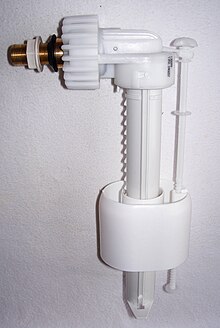Float valve
A float valve or filling valve is a valve controlled by a float: If the level falls below a certain level, the valve opens, and when the target level is reached, it closes again.
operation area
Float valves are used to ensure a certain level of a liquid in containers. The most prominent example is the cistern of a toilet . They are also used in diesel-electric submarines (for example in the German submarine class XXI from the Second World War) for the snorkel system to prevent water from getting into the air intake opening.
functionality
The float attached to a lever sinks with the liquid level. The shut-off body coupled with the lever is removed from the valve seat, thus opening the valve. On the other hand, a rising liquid level ensures that the shut-off body is pressed against the valve seat and the valve is thus closed.
further explanation
With the filling valve used in the cistern of a toilet , the simple form of the float valve is usually not used, but an integrated version of pilot and main valve. This shortens the length of the lever to which the float is attached.
The pilot valve with a much smaller diameter than the main valve is closed via the lever on the float. The resulting increase in pressure in the pilot valve chamber pushes the positively driven shut-off body of the main valve into the closed position.
There are systems on the market that differ slightly in the geometry of their rubber seals (see left figure). The rubber seal is a wearing part that must be replaced after several years. The retail price of the patented seals is one third of the total cost of the valve.



